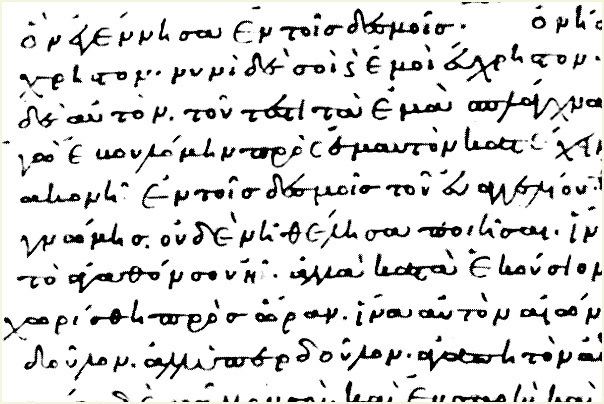Date 10th century Found 1879, Goltz Size 23 cm by 17.5 cm | ||
 | ||
Minuscule 1739 (per Gregory-Aland numbering), α 78 (per von Soden), is a Greek minuscule manuscript of the New Testament, on 102 parchment leaves (23 cm by 17.5 cm). It is dated paleographically to the 10th century.
Contents
Description
The codex contains the text of the Acts of the Apostles, Catholic epistles, and Pauline epistles. The text is written in one column per page, 35 lines per page. The Epistle to the Hebrews is placed before 1 Timothy. It contains scholia, lectionary markings were added by a later hand.
It contains a large number of notes drawn from early church fathers (Irenaeus, Clement, Origen, Eusebius, and Basil), but none later than Basil (329-379 CE), suggesting a relatively early date for 1739's exemplar. The text of this manuscript often agrees with p46 and Codex Vaticanus. A colophon indicates that while copying the Pauline epistles, the scribe followed a manuscript that contained text edited by Origen.
At the end of the Second Epistle to Timothy it has subscription Τιμοθεον Β' απο Ρωμης. The same subscription appears in manuscripts P, 6, 1881.
Text
The Greek text of this codex is a representative of the Alexandrian text-type. The Alands placed the text of the Epistles in Category I, but the text of the Acts in Category II. It was not examined by the Claremont Profile Method.
Together with manuscripts 323, 630, 945, and 1891 it belongs to the textual Family 1739 (in the Acts). In the Pauline Epistles this family includes the following manuscripts: 0121a, 0243/0121b, 6, 424, 630 (in part), and 1881.
It contains Acts 8:37, as do the manuscripts Codex Laudianus, 323, 453, 945, 1891, 2818, and several others.
In Acts 8:39, instead of πνεῦμα κυρίου ἥρπασεν τὸν Φίλιππον ([The] Spirit of [the] Lord caught up Philip)), it has the interesting textual variant πνεῦμα ἅγιον ἐπέπεσεν ἐπὶ τὸν εὐνοῦχον, ἄγγελος δέ κυρίου ἥρπασεν τὸν Φίλιππον ([the] Holy Spirit fell on the eunuch, and [the] angel of [the] Lord caught up Philip) supported by Codex Alexandrinus and several minuscule manuscripts: 94, 103, 307, 322, 323, 385, 453, 467, 945, 1765, 1891, 2298, 36a, itp, vg, syrh.
In Acts 12:25 it reads εξ Ιερουσαλημ εις Αντιοχειαν (from Jerusalem to Antioch) along with manuscripts 429, 945, e, p, syrp, copsa geo; majority reads εις Ιερουσαλημ (to Jerusalem);
In Acts 20:28 it reads του κυριου (of the Lord) together with the manuscripts
In 1 Corinthians 7:5 it reads τη προσευχη (prayer) along with
In 1 Corinthians 15:54, along with Codex Sinaiticus, 614, 629, and 1877, the text lacks (although it has been added to the margin) το φθαρτον τουτο ενδυσηται αφθαρσιαν και (This corruptible shall put on incorruption). Other manuscripts that lack this phrase are
In a marginal note to the text of 1 John 5:6, a corrector added the reading δι' ὕδατος καὶ αἵματος καὶ πνεύματος (through water and blood and spirit) as found in the following: Codex Sinaiticus, Codex Alexandrinus, 104, 424c, 614, 2412, 2495, ℓ 598m, syrh, copsa, copbo, Origen. Bart D. Ehrman says this reading is an Orthodox corrupt reading.
History
The manuscript was copied by a monk named Ephraim. He copied 1739 from an uncial exemplar from the 4th century. It was discovered by E. von der Goltz in 1879 at Mount Athos and is usually known by his name. A collation was made by Morton S. Enslin (in Kirsopp Lake Six Collations).
The codex is housed at the Great Lavra (B 184), in Athos.
